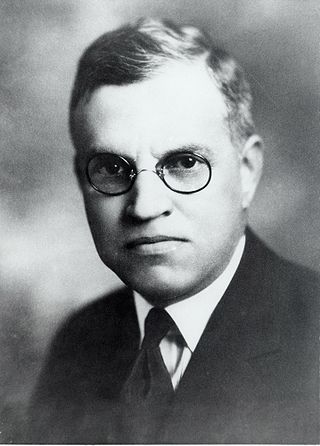
Robert Chambers Reamer (1873–1938) was an American architect, most noted for the Old Faithful Inn in Yellowstone National Park. A number of his works are listed on the National Register of Historic Places for their architecture.

The San Marco is a historic Renaissance Revival apartment building in Downtown, Spokane, Washington that was built in 1904. It was designed by architect Albert Held. San Marco was listed on the U.S. National Register of Historic Places in 1987. It is also listed on the NRHP as a contributing property in the Riverside Avenue Historic District.
Clarence Ferris White was a prolific architect in the Pacific Northwest. He designed more than 1,100 buildings, including 63 schools, in the State of Washington. His largest project was the design of the company town of Potlatch, Idaho in 1905. Several of his works are listed on the United States National Register of Historic Places.
Archibald G. Rigg was a Canadian-born American architect. Over the course of his career, he designed hundreds of buildings in the Northwestern United States.

Herman Preusse (1847–1926) was an important architect in the history of Spokane, Washington. His work includes St. Boniface Church, Convent and Rectory and Mary Queen of Heaven Roman Catholic Church. Architects such as C. Ferris White who worked in his office went on to have prominent careers. Preusse maintained a long and successful business partnership with fellow German architect Julius Zittel

Julius Zittel was an architect in Washington State. He was a draftsman at Herman Preusse firm and then became a partner at their firm. He became Washington's state architect.
James H. Nave was an American architect based in Lewiston, Idaho. He designed a number of works which are listed on the National Register of Historic Places (NRHP) for their architecture.

The Spokane Public Library is a historic building in Spokane, Washington. It was designed by architects Herman Preusse and Julius Zittel, and built in 1905. Its construction cost $100,000, with $85,000 coming from Andrew Carnegie. It has been listed on the National Register of Historic Places (NRHP) since August 3, 1982. The library is one of four historic structures at the intersection of First and Cedar. To the south across First is the Grand Coulee building. To the southeast across Cedar and First is the Eldridge Building. All three are listed on the NRHP. Additionally, the Buena Vista Apartments across Cedar are listed as a secondary contributing property to the Riverside Avenue Historic District, to which the Carnegie Library building is listed as a primary contributing property.

The Breslin is a historic six-story building in the Cliff/Cannon neighborhood of Spokane, Washington. It was designed by architect Albert Held in the Classical Revival style, and built in 1910 by W.H. Stanley with "Tenino sandstone, press red brick and cream-colored terra cotta" at a cost of $100,000.
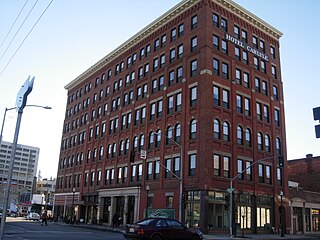
The Bump Block-Bellevue House-Hawthorne Hotel is a historic seven-story building in Downtown Spokane, Washington. It was first built in 1890, and designed by architects Loren L. Rand and John K. Dow. It was expanded in 1909, and redesigned by architects Herman Preusse and Julius Zittel. It has been listed on the National Register of Historic Places since August 10, 2000.

John K. Dow (1861-1961) was an American architect. He designed the NRHP-listed Coolidge–Rising House, the NRHP-listed Grace Baptist Church, and the NRHP-listed Empire State Building. With Loren L. Rand, he designed the NRHP-listed Bump Block-Bellevue House-Hawthorne Hotel. With Clarence Z. Hubbell, he designed the NRHP-listed Hutton Building. They also designed Van Doren Hall and the Veterinary Science Building on the campus of Washington State University in Pullman, Washington.
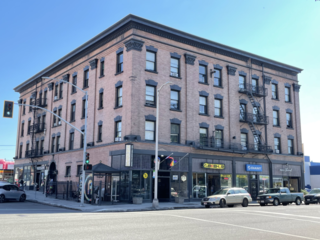
Hotel Upton, also known as Grand Coulee Hotel and Grand Coulee Apartments, is a historic four-story building in Spokane, Washington. It was designed by Loren L. Rand, and built as a 102-room hotel in 1910. It was renamed the Grand Coulee Hotel in 1933. It has been listed on the National Register of Historic Places since July 29, 1994. It is one of three historic buildings at the intersection of First Avenue and Cedar Street listed on the NRHP. To the east across Cedar is the Eldridge Building and to the north across First is the former Carnegie Library.

The Otis Hotel is a historic five-story building in Spokane, Washington. It was designed by Arthur W. Cowley and Archibald G. Rigg, and built in 1911 for Dr. Joseph E. Gandy. It was first known as the Willard Hotel, and later as the Atlantic Hotel, followed by the Earle Hotel, and finally the Otis Hotel. It has been listed on the National Register of Historic Places since October 2, 1998. The building is also listed as a contributing property to the NRHP's West Downtown Historic Transportation Corridor. After the completion of a $15 million renovation to convert the building from low income apartments back into a hotel in early 2020, the building was reopened as the Hotel Indigo Spokane and is part of the InterContinental Hotels Group.
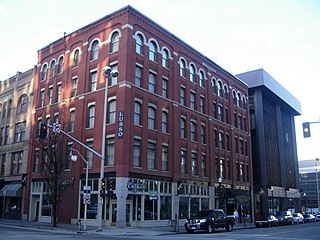
The Whitten Block is a historic five-story building in Spokane, Washington. It was designed by architect Lorenzo M. Boardman, and built in 1890 for investor Leydford B. Whitten at a cost of $40,000. Tenants included a dry goods store, a flower shop, a shoe repair store, a candy store as well as clothing stores.

Clarence Z. Hubbell was an American architect. Born in Illinois and educated at the Art Institute of Chicago, he settled in Spokane, Washington in 1900. With John K. Dow, he designed the NRHP-listed Hutton Building. They also designed Van Doren Hall and the Veterinary Science Building on the campus of Washington State University in Pullman, Washington.
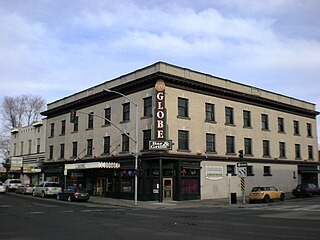
The Globe Hotel, also known as The Janet Block, is a historic three-story building in Spokane, Washington. It was designed by architect Albert Held, and built in 1908 at a cost of $80,000 for the Inland Investment Company. When it opened, the hotel had 32 en-suite rooms out of 72. It has been listed on the National Register of Historic Places since December 17, 1998.

Lorenzo M. Boardman was an American architect. Born in Pennsylvania, he was an architect in Minneapolis, Minnesota for three decades. He spent the last ten years of his life in Spokane, Washington, where he designed many buildings, including the Traders Block, Temple Court, the Ross Block, and the Windsor Block. He also designed the NRHP-listed Whitten Block.

Charles Hilpertshauser was an American architect. He designed more than 300 buildings in Sheboygan County, Wisconsin, including the NRHP-listed Henry and Charles Imig Block in Sheboygan and Hotel Laack in Plymouth.

Spokane and its neighborhoods contain a patchwork of architectural styles that give them a distinct identity and illustrate the changes throughout the city's history. Spokane has a rich architectural history for a western city of its size and much of it is a product of its circumstances at the turn of the 20th century when as a rapidly growing city, the Great Fire of 1889 destroyed 32 blocks of the city center which was quickly rebuilt in a more grand fashion by a community flush with money coming from regional mining districts. Many of the architects that found work in the city and building on the blank slate of the downtown commercial district became highly esteemed architects such as Kirtland Cutter, who has been credited with giving the city a distinctive character. In particular, the city has a high concentration of Romanesque Revival style institutional and commercial buildings and American Craftsman bungalow residences. The architecture of Spokane gained national recognition in industry publications in the early 20th century.

The West Downtown Historic Transportation Corridor is a historic commercial district in Spokane, Washington located, as the name suggests, in the western portion of the city's downtown neighborhood. The district, which was listed on the National Register of Historic Places (NRHP) in 1999, consists mostly of buildings constructed between the late 19th century and 1949. It contained at the time of listing 65 buildings or structures, 50 of which are considered contributing properties to the district. Seven properties in the district are listed on the NRHP individually as well.

















